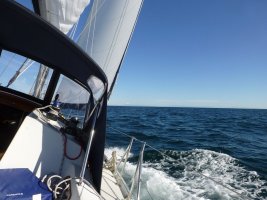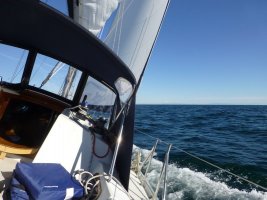e38
I believe my instruments were calibrated at the time. We had the original instruments on the boat. It was in the early 80's we had loran but no GPS
Max was 14.1 down a wave in 30-35 knots of wind on the great salt lake. Had a full main and a 105 The GSL is only 30 feet deep and the waves run for about 20 miles. Very short and steep. Hobie Alter was in the race in Hull 1 of the Hobie 33. Had sustained speeds in excess of our 14.1
A year later we were racing the Newport Ensenada Race and were steady over 10 with a rides in the 12 range. I don't know how we did it. We were coming into the finish at night with chute up. Did a dip pole jibe sailing in the 10 knot range and lived to tell tail. This was also before GPS. I still race to Ensenada and with GPS, AIS etc etc that place is still a hand full at night.
I believe my instruments were calibrated at the time. We had the original instruments on the boat. It was in the early 80's we had loran but no GPS
Max was 14.1 down a wave in 30-35 knots of wind on the great salt lake. Had a full main and a 105 The GSL is only 30 feet deep and the waves run for about 20 miles. Very short and steep. Hobie Alter was in the race in Hull 1 of the Hobie 33. Had sustained speeds in excess of our 14.1
A year later we were racing the Newport Ensenada Race and were steady over 10 with a rides in the 12 range. I don't know how we did it. We were coming into the finish at night with chute up. Did a dip pole jibe sailing in the 10 knot range and lived to tell tail. This was also before GPS. I still race to Ensenada and with GPS, AIS etc etc that place is still a hand full at night.



